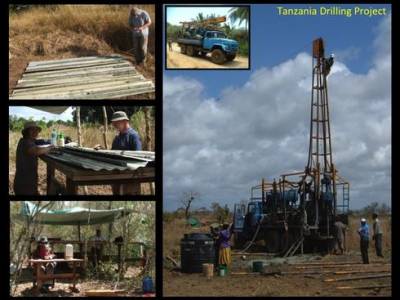Exceptional preservation and climate record onshore and offshore Tanzania.

Images from the Tanzania Drilling Project
The Tanzanian Drilling Project (TDP) is an international palaeoclimate research programme that aims to better understand the way Earth's climate has functioned during times of much warmer climate (e.g., in the Cretaceous and Paleogene) and as climate shifted from warm greenhouse climates to our current glaciated state (~33Ma). As we cannot directly measure ancient temperatures, atmospheric CO2, etc., we use indirect methods (called proxies) which are often biological compounds whose structure records these parameters. The most widely used proxies come from the calcite shells of single-celled foraminifera and the better preserved the shell, the more confidence we have in the proxy values. Tanzania has become a particular focus for our research because its Cretaceous to Miocene sedimentary rocks represent over 100 million years of Earth history and contain foraminifera that are exceptionally well preserved. Even in the ancient Cretaceous and Paleogene sediments, the foraminifera have glassy, translucent shells, looking very much as the do when living. As well as containing these exceptional foraminifera shells, the same sediments also host extraordinary and to date unique calcareous nannoplankton assemblages that have very high species diversities, many of which are new to science. This uniqueness can be explained by the preservation of small and fragile taxa that are normally lost as the coccoliths sink to the sea floor and become deeply buried in the sediment pile (Bown et al. 2008). The reason they survived in the Tanzania sediments may be the result of a combination of factors, including rapid transport to the sea floor after death, protection from dissolution by the abundant clay in these sediments, and never having been deeply buried despite their great age. Especially valuable fossil deposits such as these in Tanzania are called Konservat-Lagerstätte.
The new palaeobiological and evolutionary information from this unique nannoplankton record includes:
- a more complete picture of long-term coccolithophore diversity trends and evolution;
- documentation of previously unknown species that live in the darker, lower parts of the photic zone, including forms that are still alive at present (Gladiolithus,Algirosphaera and Solisphaera);
- improved estimates of the evolutionary origination times of modern coccolithophore families (Syracosphaeraceae and Rhabdosphaeraceae);
- documentation of the fragile holococcoliths that are usually missing from the fossil record; and,
- more complete records of the ecological and evolutionary response of the calcareous nannoplankton to rapid global change such as the Paleocene-Eocene Thermal Maximum warming event (56 million year ago), Eocene-Oligocene glaciation event (33 million years ago) and the Cenomanian-Turonian oceanic anoxic event (93 million years ago).
 Close
Close

